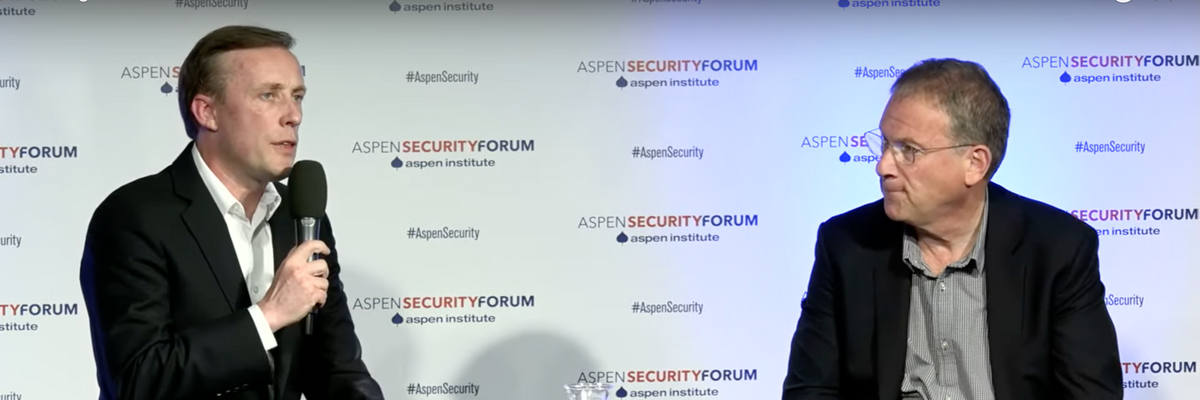Observers of what Ray McGovern, the former senior CIA analyst who has strayed well off the reservation, dubs the MICIMATT (Military-Industrial-Congressional-Intelligence-Media-Academia-Think-Tank complex) had a field day last week, given that a shoal of MICIMATTers were gathered at a festivity hosted by the Aspen Security Institute in the balmy environs of Aspen, Colorado to discuss issues of the day. Attendees had the opportunity to hear a host of panjandra including CIA Director William Burns, National Security Advisor Jake Sullivan, Air Force Secretary Frank Kendall, Under-Secretary of State Victoria Nuland, Deputy Treasury Secretary Wally Adeyemo, relicts of former administrations such as Condoleezza Rice, the chiefs of staff of the U.S. military's Northern, Southern, Special Operations, and Space commands, plus other thought leaders of the bipartisan consensus on war and aggression deliver cheery messages of triumphal bombast. Interestingly however, I did not spot any representatives of major arms contractors such as Lockheed or Raytheon in the line-up. Presumably they feel comfortable with the Help enjoying a day out without requiring direct supervision.
Some Things Better Not Considered
Present in profusion however were media cheerleaders for the consensus such as the Washington Post's David Ignatius, CNN's Jim Sciutto, and Mary Louise Kelly, co-host of NPR's All Things Considered (so long as the things being considered don't stray from the party line.) Kelly, for example, moderated a discussion on "Is the U.S. military innovating fast enough?" with the commander of the Office of Naval Research, as well as a tech entrepreneur, in which the answers throbbed with peans to drones, artificial intelligence, and other exciting high tech possibilities, but lacked any reference to the U.S Navy's near-perfect record of failure with innovative schemes such as the "stealth" Zumwalt class destroyer ($12 billion and counting, but entirely lacking in offensive weapons) or the Littoral Combat Ship program (well over $11 billion and so disastrous that the Navy itself wants to scrap half the fleet.)
Wally’s Guide to Oil Pricing
However it was a discussion on the biggest conflict currently underway, the global economic war being waged by the U.S.- controlled coalition against Russia that caught my eye. As readers of this substack should be aware, this war has not been going so well for the U.S. side, as the ruble has gone from strength to strength, Russian inflation is declining, the Russian central bank is steadily cutting interest rates, and all while Europe quakes in fear of a cut-off of Russian oil and gas supplies.
But hope springs eternal, as demonstrated by Deputy Treasury Secretary Wally Adeyemo at Aspen. Asked by interlocutor Ignatius how the U.S. plans to increase sanctions pressure on Putin, Adeyemo revealed his deep command of economic theory, explaining that "more oil equals lower prices for oil." (Actually, it doesn't, thanks to traditional and determined efforts by the oil industry to limit production, as well as Wall Street's massive speculation in oil futures, driving prices up even when there is abundant supply. But never mind.) So, Adeyemo continued, "the U.S. needs to put more oil into the market." Good luck with that. As President Biden could tell him, persuading major oil producers like Saudi Arabia to jack up production is easier said than done, or, in the case of Biden's recent plea to Mohammed Bone Saw, not done at all.
Reality Detached.
The second part of Adeyemo's master plan consists of an already widely bruited scheme to limit Putin's oil revenues by using western dominace of the marine insurance market. The price at which Russia could sell its oil would be set at a level that would allow a small profit, but no more. Only tankers carrying oil priced at that level would get insurance. “That is a way to reduce their revenue,” Adeyemo announced confidently, promising that the plan would be in operation by the end of the year. The fact that the Treasury is still promoting the scheme as a key element of Washington's master plan to bring Putin to his knees shows how detached from reality Washington has become. Various specialists who understand the oil market rather better than Adeyemo and whoever else is pushing the scheme have detailed its shortcomings. Among the clearest is Christof Rühl, senior research scholar at the Center on Global Energy Policy at Columbia University, and formerly chief economist at BP. As he explained in a podcast interview with the energy business news site BNE Intellinews soon after the price cap plan was first disclosed, it will not work, because, quite simply, "oil is fungible." Unlike gas, it is not largely dependent on pipeline distribution, but can be moved anywhere on ships. Therefore, rather than submit to the price cap regime, the Russians would simply direct more exports to Asia where, crucially, there is competition among "a whole plethora of buyers, including India, who would all bid against each other," thereby driving up the price the Russians would receive for their oil. If the Russians were still dissatisfied with the price they were getting, all they would need to do would be to reduce supply. As Adeyemo should understand, less oil means higher prices - including to the U.S., since the Indians, who have vastly increased their imports of Russian oil, are busy refining it and selling not only to Europe, but also, according to Rühl, the U.S. Furthermore, the Indian government has recently certified the entire Russian tanker fleet, making it eligible for Indian insurance coverage. As fellow panelist on the podcast Chris Weafer, CEO of Macro Advisory, exclaimed of the western economic warriors, "what planet are they living on?"
The same query might be applied to the happy conferees at Aspen.
This piece has been republished with permission from Spoils of War.














